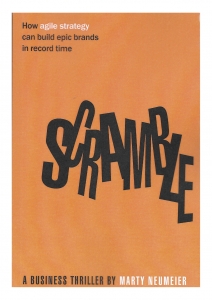 I have abandoned my normal format to summarise this intriguing book and give more detail than usual. Anyone interested in the full works should, apart from buying the book, download the guide to agile strategy at www.martyneumeier.com
I have abandoned my normal format to summarise this intriguing book and give more detail than usual. Anyone interested in the full works should, apart from buying the book, download the guide to agile strategy at www.martyneumeier.com
- This book is a business thriller – a story that culminates in a Guide to Agile Strategy. Conventional wisdom has it that building a successful business or brand strategy takes a good 6-18 months. It apparently calls for completing a series of tasks one by one with a process like this: 1. Assess your current position 2. Research the market for threats and opportunities 3. Envision a range of scenarios 4. Get agreement on a direction 5. Establish a coherent vision 6. Identify strategic goals 7. Translate the goals into tactics 8. Arrange for funding
- It’s a long list of sequential steps, each step building on the one before. But what if you approached the steps simultaneously instead of sequentially?
- This is called agile strategy. By adopting a more collaborative approach to strategy, and working simultaneously, agile teams can complete a framework for a new business or brand in fewer than six weeks.
- The process of agile strategy is simple. You apply the five principles of design thinking (called the five Ps) to the five questions of strategy (called the five Qs). 5Qs × 5Ps = Agile strategy.
- The Ps and Qs are not set in stone. They’re flexible, adaptable, and customizable. You can use them as a starting place, then adapt them to your own situation.
- Design thinking is the process of using prototypes to work through creative challenges. You might define it as thinking by making. The easiest way to understand design thinking is to contrast it with traditional business thinking. Traditional thinking has two main steps: knowing and
- The five Ps of design thinking are a set of principles for imagining and developing new ideas. They’re specifically designed to force your mind beyond the obvious.
- Third-pasture thinking is the concept of going beyond the obvious to find the freshest ideas. When horses are turned out in a field to eat, the pickiest ones don’t settle for the trampled grass in the lowest pasture. They climb higher, up to the second pasture, and even to the third, where the grass is truly fresh.
- The five Ps are problemizing, pinballing, probing, protyping, and They provide a framework for finding third-pasture ideas.
- Problemizing
Problemizing isn’t about solving problems, but about framing them. Never accept a problem at face value. Instead, try to find out what the real problem is—the problem behind the problem—by asking a few questions.
Is this the right problem to solve?
Is it worthy of our best efforts?
What other problems could we solve that would bring more value to the company or our customers?
Problemizing is divided into three steps:
1) Stating the problem
2) Listing the benefits of solving it
3) Describing the penalty for ignoring it
- Pinballing
The same way a pinball bounces off obstacles and other pinballs, ideas can bounce off obstacles and other ideas. Now that you understand the problem, how many courses of action can you imagine?
- Probing
Edward de Bono’s seminal book, Six Thinking Hats is based on the idea of parallel thinking—a technique in which the members of a brainstorming group think in the same direction at the same time. You take an idea from the pinballing stage and view it through the six hats. The white hat is for information, the red hat for emotion, the black hat for caution, the yellow hat for positivity, and the green hat for creativity. The blue hat is reserved for the leader, who determines which hat the group wears at any given time.
- Prototyping
Prototyping is the magic that makes design thinking more powerful than traditional thinking. It adds the making step between knowing and doing. It’s the difference between deciding the future with off-the-shelf practices, and designing the future by working from first principles. A prototype is simply a rough approximation of an idea, product, service, or process—whatever it is you’re inventing. It can be a sketch, a mockup, a model, a story, a bit of role-playing. The goal is to keep it simple, throw it together fast, and learn from the results. You then apply what you’ve learned to the next prototype, and so forth, round after round.
- Proofing
Prototypes are essential for testing and learning. With a prototype, you can try out your ideas on prospective customers. You can see what’s working, what’s not working, and where to make improvements. You can use them to get feedback from colleagues, bosses, or clients. And yet you need to be wary of assumptions. We all make assumptions about the way the world works, but they can blind us to possibilities—and even reality itself. Proofing is the fastest way to test your assumptions against the realities of the marketplace. To get the most out of proofing, test two or more prototypes against each other. The five Qs of strategy address the critical questions of purpose, customer, category, positioning, and culture.
- What is our purpose?
- Who do we serve?
- Where should we compete?
- How will we win?
- How will we grow?
Ultimately, fill in this sentence:
OUR BRAND IS THE ONLY ___________ THAT ____________.
